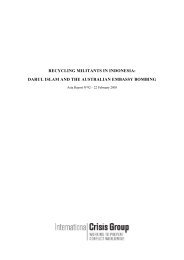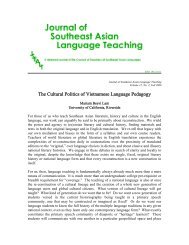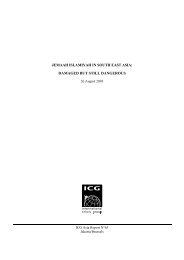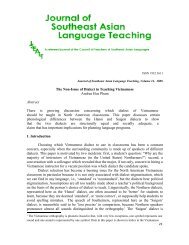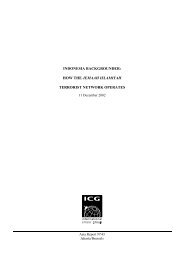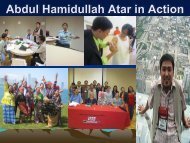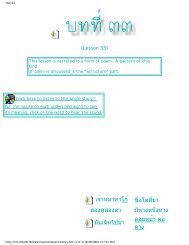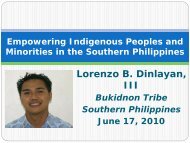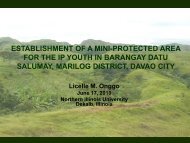Introduction - SEAsite - Northern Illinois University
Introduction - SEAsite - Northern Illinois University
Introduction - SEAsite - Northern Illinois University
You also want an ePaper? Increase the reach of your titles
YUMPU automatically turns print PDFs into web optimized ePapers that Google loves.
Prentation Abstracts<br />
sphere of northern Laos in the sphere of Lue temple and activities initiated by the<br />
Association. However the Lue organization and people’s grouping are definitely<br />
beyond “pure” ethnic identity, i.e., almost all non-Lao Laotians originated from<br />
northern muangs join the Association entitled by ethnonym Lue. In this paper I am<br />
going to argue that Lue as a symbol of integrating northerners has become one of<br />
the major identities deposited in individual’s inventory of ethnicities among most<br />
of Luang Lamthalites in Seattle. There is a pan-Lue world in northwest coast of<br />
North America that evidently distinguished from the majority Lao in most arena<br />
of daily lives.<br />
Aviva Imhof<br />
Is Hydropower the Best Option for Laos’ Development?<br />
Campaigns Director, International Rivers Network, California<br />
The Mekong River forms the heart and soul of mainland Southeast Asia, providing<br />
sustenance, drinking water and transport for more than 65 million people<br />
living along its banks. Known as the “Mother of Waters,” the Mekong River supports<br />
one of the world’s most diverse fisheries, second only to the Amazon. The<br />
Mekong’s annual flood-drought cycles are essential for the sustainable production<br />
of food crops on the floodplains and along the banks of the rivers during the dry<br />
season.<br />
Laotians depend on the Mekong River and its many tributaries for all aspects<br />
of their lives – wild-caught fisheries make up 80% of the dietary protein of people<br />
in the country. People depend on rivers to irrigate and fertilize their rice fields, to<br />
grow vegetables along riverbanks during the dry season and for transportation,<br />
drinking water and many other uses. River development projects threaten not only<br />
the integrity of the river ecosystem but the livelihoods of communities who depend<br />
on the river for their survival.<br />
Hydropower projects have been promoted in Laos for national development<br />
and poverty alleviation. Since the late 1980s, the World Bank, Asian Development<br />
Bank and other international donors have advised the Lao government that the<br />
best option for development is to build hydropower dams and export the power<br />
to neighboring Thailand. This would provide the Lao government with foreign<br />
exchange that can be used to fund development activities in the country. However,<br />
the track record of building and implementing dam projects in the country has<br />
been poor, depriving communities of access to natural resources essential for their<br />
survival.<br />
Five hydropower projects developed over the past decade have damaged<br />
fisheries and river ecosystems that people depend on for their food security and<br />
well-being. Tens of thousands of Laotians now lack sufficient food to eat, clean<br />
water to drink and income to meet basic needs because of dam projects. As there<br />
are no independent agencies within Laos to monitor the government’s commitments,<br />
affected communities remain isolated, marginalized and intimidated from<br />
voicing concerns.<br />
At the end of March, 2005, the World Bank and Asian Development Bank<br />
approved the controversial Nam Theun 2 hydropower project in Laos, arguing<br />
that the project will generate much-needed foreign exchange to alleviate poverty<br />
in Laos. However, Nam Theun 2 will displace 6,200 indigenous people living on<br />
the Nakai Plateau and will affect another 100,000 people living downstream of<br />
the project along the Xe Bang Fai and Nam Theun who rely on these rivers for<br />
fish, drinking water and agriculture. Most of these people are subsistence farmers<br />
dependent upon natural resources for their livelihoods. Experience from other<br />
hydropower projects in Laos shows that replacing subsistence livelihoods is extremely<br />
difficult. Independent reviews of the mitigation and compensation plans<br />
reveal that these plans are overly ambitious and have a high likelihood of failure.<br />
This paper will discuss the experience with hydropower development in<br />
Laos and explore whether hydropower is indeed the best option for Laos’ development.<br />
Faith Inman, poster presentation<br />
Predicting Primary Forest Recovery in a Fragmented<br />
Landscape: a Restoration Roadmap<br />
Botany Department, North Carolina State <strong>University</strong>, North Carolina<br />
To develop a predictive model for primary forest species establishment following<br />
disturbance, I propose to conduct experiments to measure dispersal and<br />
recruitment of primary forest species in three different habitats: primary forest,<br />
secondary forest, and pasture, and determine the relationship between these variables<br />
and seed characters along the environmental gradients found in the three<br />
habitat types. This information will be used to construct a model that will generate<br />
establishment probabilities for species under specified environmental conditions.<br />
This model will be used to determine which primary forest species will require intensive<br />
management (seeding, planting, etc) under a variety of environmental conditions.<br />
An interesting study site I have identified is the Nam Ha National Preserve<br />
Area in northwestern Laos. According to satellite imagery, this 222,000 hectare<br />
preserve is a mosaic of primary forest, secondary forest, and recently abandoned<br />
pasture. Furthermore, the dominant primary forest trees in the lowland moist forest<br />
in Laos are wind-dispersed Dipterocarps, which may present the opportunity to<br />
study a novel relationship between dispersal traits and environmental conditions.<br />
Bounheng Inversin, MSW<br />
Lao Women: Transmitters of Tradition and Culture<br />
Lao American Women Association (LAWA), Washington, D.C.<br />
There is an old saying among the Lao Lum people that a family is like an<br />
elephant. The man is compared to the front legs initiating the ‘first’ steps. The<br />
ability to move or advance depends greatly on the cooperation of the hind legs.<br />
The woman being compared to “the hind legs of an elephant” makes her the major<br />
contributor in all things possible for a family. Like a family, Lao society relies on<br />
its womenfolk for the teaching, preserving, and transmitting of tradition and culture<br />
to younger generations. Sayings such as “When choosing a wife, make sure<br />
to check out her mother first” or “Language tells where a person is from, his manners<br />
reveal his family background” may no longer be as fully applicable or valid<br />
today, but they highlight the important teaching role that women have assumed to<br />
ensure that their children are important assets and not a nuisance to the family and<br />
a shame to the society.<br />
Although there are advantages to be globally in tune, there is, at the same<br />
time, an outcry to remain individual. According to Patricia Schultz, one of the<br />
“1,000 Places To See Before You Die” is Laos. What makes Laos attractive?<br />
Among her natural beauty are her people, culture, food, and textiles to name a few.<br />
A people’s behavior, language, cuisine, and textiles motifs certainly are a heritage<br />
that was passed down from generation to generation. And throughout the millennia,<br />
women have been playing major roles in such generational connection.<br />
This paper will present the contribution of women as transmitters of tradition<br />
and culture in the Lao Lum people of Laos rather than the general Laotian women.<br />
It will touch on the contribution of Lao American women as preservers of Lao<br />
heritage for the next generation growing up far from Laos. The chapter “Beyond<br />
Pabieng” will present the challenges that these women face in re-creating a traditional<br />
culture in their new environment.<br />
Hirota Isao, Hyakumura Kimihiko, Ochiai Yukino, Yokoyama<br />
Satoshi and Kono Yasuyuki<br />
Land Use and Livelihood in Laos: From Field Studies on<br />
Forestry, Agriculture and Plant Resource Management<br />
Japan<br />
Concerning the rural life in Laos, many ethnic groups currently adopt their<br />
own land use system and practice various subsistence activities depending upon<br />
the natural environmental conditions of each place. This is a notable feature of<br />
rural Laos. In particular, farmers in Laos are commonly engaged in swidden agriculture<br />
for food production and hunting animals and gathering plants for domestic<br />
use, while in other areas in mainland Southeast Asia, such as northern Vietnam<br />
and Yunnan Province of China, these traditional activities are rarely found, even<br />
though the same ethnic groups inhabit in both areas. Moreover, many farmers in<br />
Laos are still occupied in self-sufficient agriculture by using indigenous practices,<br />
in spite the commercial and modern agriculture have been developing in the surrounded<br />
areas.<br />
The geographical features of mountains and low population pressure can account<br />
for the maintenance of traditional agriculture in Laos. Probably, insufficient<br />
infrastructure development and low influence of government leading for modernization<br />
could be considerable obstacle for Laotian farmers to engage marketable<br />
and intensive agriculture. These may be also the reasons why wide ranged land use<br />
system and subsistence activities are preserved in the current rural Laos.<br />
However, one can hardly imagine that this situation should continue in the






